|
Wildwood
WILDWOOD is a thoroughly
comfortable camp, easily constructed. The living room is large enough to
contain a fireplace and chimney of ample dimensions. A thimble should be
put in the chimney to accommodate the pipe from a stove in the dining
room in the event of very severe weather, though the stove in the
kitchen will keep the dining room very comfortable late in November in
Maine.
The doorway between the
living room and dining room might be made wider than is shown on the
plan, with a simple drapery hung. The stairway is two feet wide, with a
rustic balustrade made of peeled poles about three inches in diameter.
Underneath, in the dining room, is a low closet. The stairs wind half
way up and cut through the partition, making a large closet underneath
in the bedroom.
Upstairs there is quite a
large room over the dining room and bedroom, ten by fourteen feet, with
the space on either side of the room, where the eaves slope to the
floor, partitioned off with a series of frame doors, covered behind with
burlap, and hinged at the top to swing up against the roof. These are
about four feet high, and so a very considerable storage space is
obtained behind them. The room is used as a sleeping room, and contains
one window.
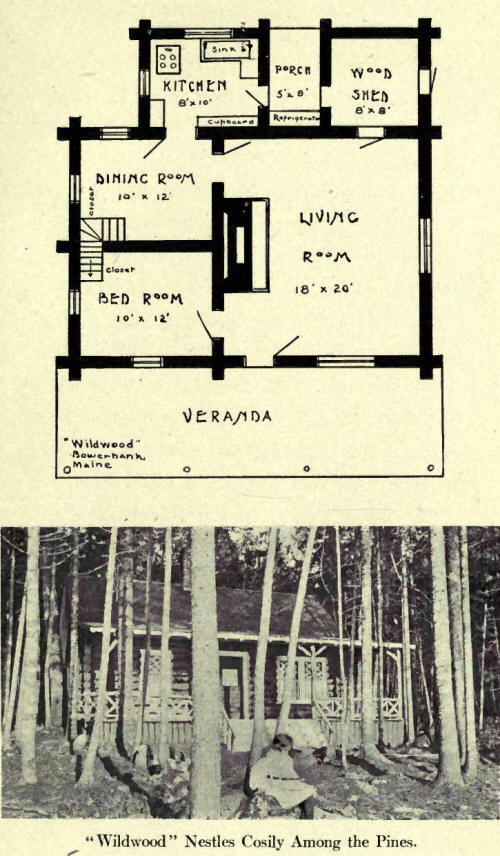
In the kitchen everything
is at hand. The stovepipe is run through the side of the house and is
kept from contact with the woodwork by passing through a terra cotta
pipe of larger dimensions. The window is hinged at the top and opens
inside against the roof.
The refrigerator is on
the back porch, and over it are built a set of shelves with screen
doors, where fish and game may be safely kept. The whole entrance to the
porch is screened and a screen door is set in the center. The woodshed
is convenient and contains one window with a door instead of a sash,
through which the wood may be thrown for piling. Should the door leading
from the woodshed into the living room be found undesirable, cut only a
small one near the floor, which may be covered with a box seat. Thus you
will acquire a wood box that may be readily filled from the woodshed.
Crow's Nest
Light and air are
liberally provided for in the cabin design of Crow's Nest by very long
windows opening on hinges. Their shape is also designed so that the view
from inside the rooms is always properly framed. A window in the peak of
the cabin should be small and capable of being opened by a cord from
inside. This will afford a needed outlet for heated air during the long
summer days. Provide suitable shutters to fasten over the windows on
closing the camp for the season.
It will be found
advisable in the smaller type of cabin to make the window seats in box
form, with removable top for storage space. If but a single floor is
laid, line the boxes with tin. This will protect your blankets, etc.,
from the mice and other vermin that are sure to get in the house.

If your spring is not
nearby, a great labor-saving device can be arranged as follows: Take a
barrel and fasten it at the right height, so that the water will run out
of it by means of a small pipe, connecting the sink and regulated by a
faucet. A V-shaped trough, suspended under the eaves, will keep the
barrel supplied nearly all the time. At any rate a half hour spent in
filling the barrel now and then is much easier than carrying water each
day. Of course, for cooking and drinking the usual trip to the spring
must be made, unless one has the ingenuity to make the spring come to
him. An icebox, built into the wall and capable of being filled from the
outside, will be found a great convenience.
Don't forget to cover the
adjacent wall with zinc before setting up the stove.
A Club House
A log-cabin structure is
particularly adapted for the home of a club of out-door lovers. It was a
great pleasure to design the club house shown here, in response to the
following: "Please publish an article on how to erect a small,
modest-priced club house for a club of ten or twenty; we have such a
club, and we want to build one next fall. Of course, a good-sized living
or club room would have to be incorporated
in the plan."
The simplest form of club
house I can think of is the camp of a logging crew, which might be
thirty-five feet long by twenty wide. On one side are double tiers of
bunks, on the other side is the long table, while the big stove occupies
the center, and around it the crew congregate after the day's chopping
to do their mending and have a smoke before turning in. In about twenty
minutes the air is redolent of tobacco smoke, the smell of cooking and
the steam from the wet clothing hung about to dry.
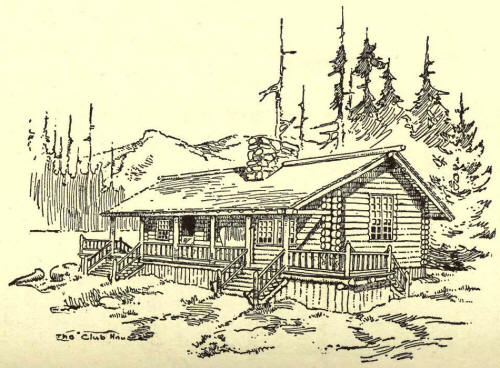
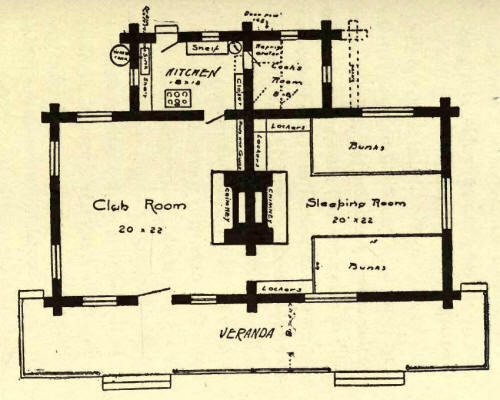
Now, if the objectionable
features of the logging camp could be eliminated and desirable ones
substituted without any great increase in cost, our task would be easy.
Unfortunately this cannot be done altogether; but the design shown
combines all the good features compatible with a moderate-priced
structure.
The club room is divided
from the sleeping room by a partition of logs. In the center of the
partition the chimney is set with opening for a fire in each room. The
design of this should differ in each room to add the charm of variety.
To the right of the chimney a doorway, hung with curtains, leads into
the sleeping room, and to the left a case with spaces for guns and rods
is provided. A swinging door leads into the kitchen.
In the sleeping room are
tiers of lockers, which afford storage for the members' clothing, etc. A
hole, covered with wire screening, should be cut near the top of each
locker for ventilation. It is a good rule to incorporate in the "House
Laws" that no damp clothing is to be put in the lockers. Rig a
clothesline back of the house, where things can be dried and sunned, and
keep the sleeping apartment as sweet and wholesome as possible.
The bunks provide
sleeping space for ten people, allowing three feet to each person. If
there are more than ten, a second tier should be built, but should be at
least six feet above. The bottom of these bunks should be lined with
building paper, to prevent the dust, etc., from sifting down on the
sleepers beneath. Build your bunks very solid, with supporting posts
every three feet in front, and on every other one nail cleats for
ladders to the upper berths.
If two tiers of berths
are used, the windows on either side of the cabin will have to be
omitted and the window in the end made larger and very tall.
Under the shelves and
closet in the kitchen additional shelves should be made, with doors
enclosing your supplies. A large hogshead for water should be set up
outside, with pipe and faucet to the sink.
A door leads from the
kitchen into the cook's room; but if the slight additional expense is no
objection, three feet can be added to the length of the room and a
partition put up. This will give a space for a refrigerator or icebox
and ample room for storing supplies. Incidentally it would make a
capital dark room in addition. A window should be put in the end of the
pantry and a door cut into the refrigerator, so that the ice may be put
in from the outside.
The Block House
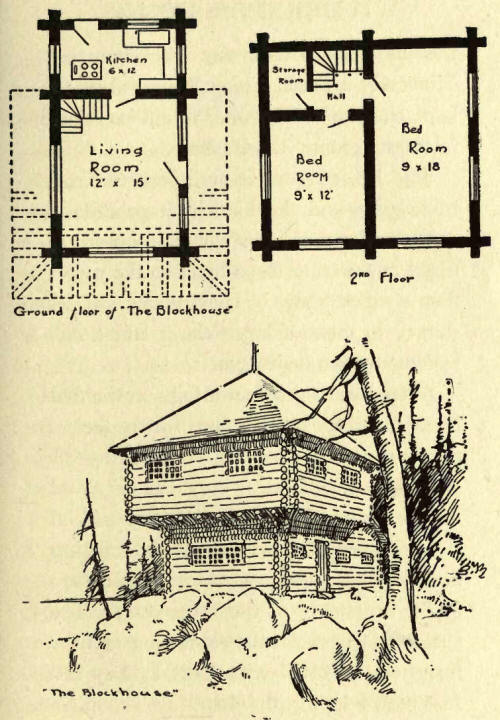
The Block House is our
concession to a two-story structure. Occasionally a site will be chosen
for which this form of cabin is adapted, and it should be erected as
simply as the drawing indicates. Any deviation in the way of elaboration
would cause the building to instantly lose character. However, a porch
without any railing, if kept close to the ground, might be added to
extend around three sides.
The living room is well
lighted from three sides and the kitchen is practically separate from
the rest of the house. A flight of winding steps leads to the upper
floor, which may be partitioned off as shown, to make a large closet and
a hall leading to two bedrooms.
After the last course of
logs on the first floor is Iaid, the long timbers for the second floor
are put in place, as indicated by the dotted lines in the drawing. At
the front of the house shorter timbers are laid at right angles, their
notched ends fitting underneath the last joist and resting on top of the
course log of the lower story. The spaces left between the course log
and the floor will be fitted with short logs spiked fast before laying
the floor.
Idlewild
For an easily constructed
cabin, full of character and thoroughly homelike, Idle-wild is ideal.
There is always a shady nook on the veranda to be enjoyed, and the
absence of a covering for this on either side permits an abundance of
light and air to reach the living room.
This is a small cabin,
but if it be raised three or four feet from the ground and the veranda
railing and other rustic features are accented, the whole will take on
an air of largeness and comfort, and the result will be thoroughly
artistic.
Over the bedrooms and
kitchen a floor should be laid, if possible, and a small window cut, in
either of the storage rooms thus obtained, for ventilation. This space
will make a vast difference in the temperature of the rooms beneath
during a heated term.

If one of the windows in
the end should be of generous size, it would enable you to stow your
canoes very conveniently here in the absence of a boathouse.
The Jolly Pines
The Jolly Pines is a
compact cabin, with ample room for the full enjoyment of such of the
vacation time as must be lived indoors.
The front door of the
living room is double and the windows are of the casement type, so that
the entire front of the house may practically be thrown open.

In this case the chimney
is built up inside the cabin and occupies a corner of the room. The
partitions should be carried up to meet the slant of the roof, and thus
you will obtain a large and airy room of special interest, because of
the varying pitches of the roof, with its system of rafters and the
unusual situation of the fireplace. This should face the front door as
nearly as possible.
The bedroom and kitchen
may be floored over to gain additional storage space and to assist in
keeping the temperature down.
The Antlers
By partitioning off part
of the veranda one gains considerable space, which may be utilized as a
bedroom. If more porch room is needed, it may easily be obtained by
adding an uncovered veranda to the end of the house.
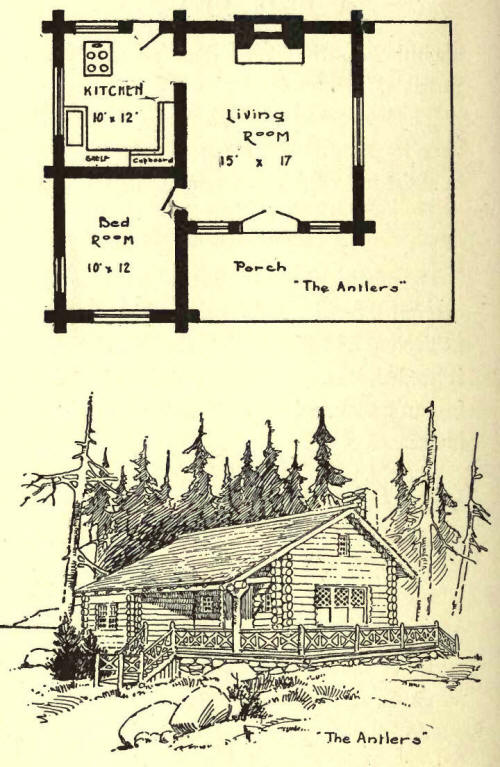
Should you desire to
build the chimney outside the cabin, cut a hole in the wall large enough
for the fireplace, including the shelf. Then proceed to build according
to the directions in the body of the book. The fireplace need not in
this case project very far into the room. A small window on either side
of the fireplace and high up would assist materially in obtaining a
draught on a hot day. This would leave space beneath for bookshelves,
seats, or gun cases, etc. In any of the structures do not fail to make
ample allowance for the storage of dishes and supplies. It may often
happen that a space beneath the floor reached by a trapdoor could be
built with little trouble and large gain.
The size of the kitchen
might be curtailed if it seems, desirable to make the bedroom larger.
Whenever half doors are
used a batten should be placed on the upper half that will lap over the
lower half about one inch. This will give you protection from draughts
and from the driving rains which often beat against the walls beneath
the porch roofs. |

